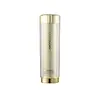What's inside
What's inside
 Key Ingredients
Key Ingredients

 Benefits
Benefits

 Concerns
Concerns

No concerns
 Ingredients Side-by-side
Ingredients Side-by-side

Camellia Sinensis Leaf Water
MaskingButylene Glycol
HumectantWater
Skin ConditioningGlycerin
HumectantAlcohol
AntimicrobialTrehalose
HumectantPhyllostachys Bambusoides Juice
Skin ConditioningGlycereth-26
HumectantHydrogenated Poly(C6-14 Olefin)
EmollientDimethicone
EmollientHydrogenated Lecithin
EmulsifyingPropanediol
SolventPentaerythrityl Tetraethylhexanoate
EmollientPolymethylsilsesquioxane
Panthenol
Skin ConditioningCetearyl Olivate
1,2-Hexanediol
Skin ConditioningPEG-5 Rapeseed Sterol
CleansingSorbitan Olivate
EmulsifyingSodium Polyacrylate
AbsorbentHydrogenated Polydecene
EmollientParfum
MaskingAmmonium Acryloyldimethyltaurate/Vp Copolymer
Acrylates/C10-30 Alkyl Acrylate Crosspolymer
Emulsion StabilisingXanthan Gum
EmulsifyingTromethamine
BufferingGlycyrrhiza Glabra Root Extract
BleachingAdenosine
Skin ConditioningDisodium EDTA
Ethylhexylglycerin
Skin ConditioningBeta-Glucan
Skin ConditioningPPG-5-Laureth-5
EmollientGlycine Soja Seed Extract
Skin ConditioningNatto Gum
Dextrin
AbsorbentTheobroma Cacao Extract
Skin ConditioningCamellia Sinensis Leaf Extract
AntimicrobialPhenoxyethanol
PreservativePoloxamer 235
EmulsifyingBetaine
HumectantEthoxydiglycol
HumectantEpigallocatechin Gallate
AntioxidantCamellia Sinensis Flower Extract
PerfumingTocophersolan
AntioxidantPoloxamer 338
EmulsifyingPanax Ginseng Root Extract
EmollientGlucose
HumectantAcetic Acid
BufferingPotassium Hydroxide
BufferingCaprylyl Glycol
EmollientTocopherol
AntioxidantCamellia Sinensis Leaf Water, Butylene Glycol, Water, Glycerin, Alcohol, Trehalose, Phyllostachys Bambusoides Juice, Glycereth-26, Hydrogenated Poly(C6-14 Olefin), Dimethicone, Hydrogenated Lecithin, Propanediol, Pentaerythrityl Tetraethylhexanoate, Polymethylsilsesquioxane, Panthenol, Cetearyl Olivate, 1,2-Hexanediol, PEG-5 Rapeseed Sterol, Sorbitan Olivate, Sodium Polyacrylate, Hydrogenated Polydecene, Parfum, Ammonium Acryloyldimethyltaurate/Vp Copolymer, Acrylates/C10-30 Alkyl Acrylate Crosspolymer, Xanthan Gum, Tromethamine, Glycyrrhiza Glabra Root Extract, Adenosine, Disodium EDTA, Ethylhexylglycerin, Beta-Glucan, PPG-5-Laureth-5, Glycine Soja Seed Extract, Natto Gum, Dextrin, Theobroma Cacao Extract, Camellia Sinensis Leaf Extract, Phenoxyethanol, Poloxamer 235, Betaine, Ethoxydiglycol, Epigallocatechin Gallate, Camellia Sinensis Flower Extract, Tocophersolan, Poloxamer 338, Panax Ginseng Root Extract, Glucose, Acetic Acid, Potassium Hydroxide, Caprylyl Glycol, Tocopherol
 Reviews
Reviews

Ingredients Explained
These ingredients are found in both products.
Ingredients higher up in an ingredient list are typically present in a larger amount.
1,2-Hexanediol is a synthetic liquid and another multi-functional powerhouse.
It is a:
- Humectant, drawing moisture into the skin
- Emollient, helping to soften skin
- Solvent, dispersing and stabilizing formulas
- Preservative booster, enhancing the antimicrobial activity of other preservatives
Camellia Sinensis Leaf Extract is derived from the leaves of the tea plant. Black tea, green tea, and oolong tea are all harvested from this plant.
This ingredient has many skin benefits:
This ingredient contains polyphenols, a strong antioxidant. Antioxidants help fight off molecules that damage skin cells.
On top of that, the antioxidants in green tea neutralize free-radicals from the sun. This gives the skin some extra UV protection, but should not replace sunscreen.
Many components of tea have anti-inflammatory properties.
Polyphenols and L-theanine help soothe the skin and reduce irritation. The caffeine in Camellia Sinensis Leaf Extract helps calm inflamed blood vessels.
Other compounds found in tea include: Vitamin Bs, linoleic acid, magnesium, calcium, iron, and zinc.
Research has shown both drinking Camellia Sinensis Leaf Tea and applying it to the skin can help boost skin elasticity and hydration. Studies also show using tea extract may reduce sebum, or oil, production.
Learn more about Camellia Sinensis Leaf ExtractEthylhexylglycerin (we can't pronounce this either) is commonly used as a preservative and skin softener. It is derived from glyceryl.
You might see Ethylhexylglycerin often paired with other preservatives such as phenoxyethanol. Ethylhexylglycerin has been found to increase the effectiveness of these other preservatives.
Glycerin is already naturally found in your skin. It helps moisturize and protect your skin.
A study from 2016 found glycerin to be more effective as a humectant than AHAs and hyaluronic acid.
As a humectant, it helps the skin stay hydrated by pulling moisture to your skin. The low molecular weight of glycerin allows it to pull moisture into the deeper layers of your skin.
Hydrated skin improves your skin barrier; Your skin barrier helps protect against irritants and bacteria.
Glycerin has also been found to have antimicrobial and antiviral properties. Due to these properties, glycerin is often used in wound and burn treatments.
In cosmetics, glycerin is usually derived from plants such as soybean or palm. However, it can also be sourced from animals, such as tallow or animal fat.
This ingredient is organic, colorless, odorless, and non-toxic.
Glycerin is the name for this ingredient in American English. British English uses Glycerol/Glycerine.
Learn more about GlycerinPropanediol is an all-star ingredient. It softens, hydrates, and smooths the skin.
It’s often used to:
Propanediol is not likely to cause sensitivity and considered safe to use. It is derived from corn or petroleum with a clear color and no scent.
Learn more about PropanediolWater. It's the most common cosmetic ingredient of all. You'll usually see it at the top of ingredient lists, meaning that it makes up the largest part of the product.
So why is it so popular? Water most often acts as a solvent - this means that it helps dissolve other ingredients into the formulation.
You'll also recognize water as that liquid we all need to stay alive. If you see this, drink a glass of water. Stay hydrated!
Learn more about Water